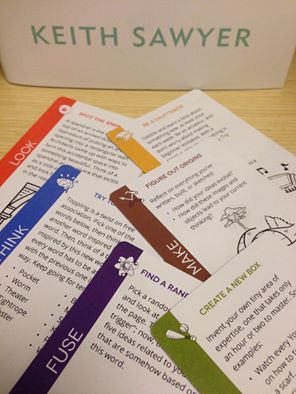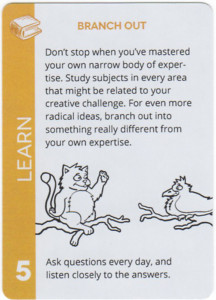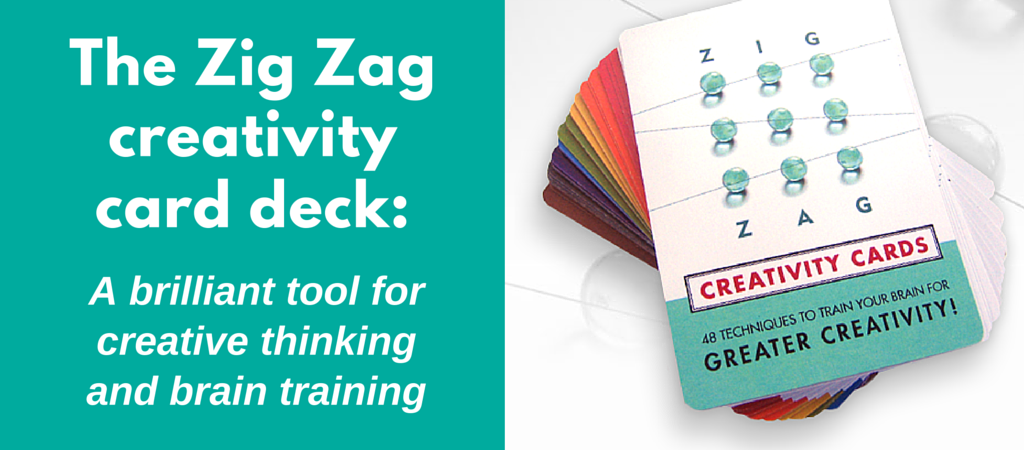One of the best creativity books of the last decade is Zig Zag: The Surprising Path to Greater Creativity by Dr. Keith Sawyer. That’s why I was very excited to hear that he has developed a creativity card deck based on his excellent book.
The Zig Zag creativity card deck contains 48 techniques and four games that are designed to help you break through creative impasses, generate new ideas, and exercise your creative brain. They can be used for solo or group brainstorming, as well as creative facilitation.
As you may know if you’ve read this blog for any period of time, I am a huge fan of creativity tools. They serve as catalysts to help you get your brain thinking in fresh, new directions. By extension, they whack your mind out of its habitual paths, a habit all of us tend to fall into. A tool that is grounded in a strong creative problem-solving framework and scientific research – like the Zig Zag card deck – is pure creative gold!
Dr. Keith Sawyer, a psychologist, professor, jazz pianist, and former videogame designer, is one of the world’s leading experts on creativity. He is the Morgan Distinguished Professor in Educational Innovations at the University of North Carolina at Chapel Hill.
What’s in the card deck?
 Zig Zag creativity card deck consists of 48 cards, which are grouped to follow Sawyer’s 8-step ideation process:
Zig Zag creativity card deck consists of 48 cards, which are grouped to follow Sawyer’s 8-step ideation process:
- Ask: how to ask the right questions
- Learn: prepare your mind
- Look: spot the answers around you
- Play: imagine possible worlds
- Think: how to have great ideas
- Fuse: how to combine ideas
- Choose: make good ideas even better
- Make: make your ideas visible
The clear, concise instructions included in the card deck explain how to use it for 4 creative thinking games. The deck comes in a a high-quality clear plastic case that protects the cards from damage when you’re carrying them in a briefcase or bag.
Example Zig Zag cards
Here are several examples of the cards contained in the Zig Zag creativity card deck:
Step: Make
Technique: Draw a picture
This card encourages you to visualize your idea. Turn it into a cartoon, with bold exaggerated shapes. Simplify it into an icon-like drawing. Use colored crayons or felt tip markers to add color to your visualization of your idea. This is excellent advice, because visualizing an idea accesses different parts of your brain than writing or typing them does – increasing the odds of a creative breakthrough.
 Step: Choose
Step: Choose
Technique: Map the grid
This card asks you to list three qualities of any great ideas that would solve your creative challenge. These are general qualities that would be most useful in determining the value of ideas like the ones you have generated. Next, this card asks you to write them across the top of a blank page. Rate the importance of each quality on a scale of 1 to 10. In other words, these evaluation criteria can have different “weights.”
Next, list your ideas on the left, and give a 1 to 10 rating for how well each idea satisfies each quality you’ve listed at the top of the page. To calculate the total value of each idea, multiply the rating in each cell by the importance of that column’s quality, and add up the products. This is a very simple way to identify criteria and to calculate the value of each potential idea. You can easily do it by hand in a notebook, or semi-automate it in a computerized spreadsheet.
Step: Look
Technique: Shape your day
First thing in the morning, select a basic geometric shape, such as a circle, triangle or square. As you go through your day, look for examples of that shape in the every day objects and scenes around you. Then try to make connections between those objects and the challenge you face, no matter how far you have to stretch to make the link.
I love this technique! It’s somewhat similar to environmental creativity, where you use random items in your environment as creative stimuli. But it takes this idea one step further, asking you to be more aware of what’s around you in your quest to fdind specific examples of your chosen shape. Practicing to sharpen your observation skills is always a valuable exercise!
Creativity on demand
Each of the exercises in the Zig Zag creative card deck can be done in only a few minutes, which encourages you to take it with you, pull it out and practice creative problem solving whenever you have a few spare moments. It’s a painless way to expand your brain’s creative capacity. Of course, you can also use it to help solve specific problems or challenges.
I love the variety of stimuli and creative thinking exercises that are included in this excellent card deck. Whether you have a specific challenge you’re trying to solve, or you are looking for fun and thought-provoking ways to increase your day-to-day creativity, the Zig Zag card deck is an excellent investment. I highly recommend it!
The Zig Zag card deck is available from Amazon.com for US$19.95. You can also learn more about it at the tool’s website, zzdeck.com.


This is a great summary of my creativity cards! And, with some wonderful photos that do a great job of showing you exactly what they look like. Don't forget to read the "Card of the day" at zzdeck.com, it changes every day.